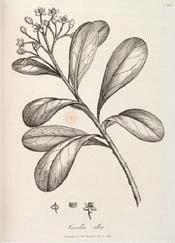
Botanical.com Home Page

|
Wild cinnamon
(Canella alba)
Click on graphic for larger image
|
Cinnamon, White
Botanical: Canella alba (MURRAY)
Family: N.O. Canellaceae
---Synonyms---Canella. White Wood. Wild Cinnamon. Canellae Cortex.
---Part Used---The bark, deprived of its corky layer and dried.
---Habitat---The West Indies and Florida.
---Description---A straight tree, from 10 to 50 feet in height, branched only at the top. The bark is whitish and the leaves alternate, oblong, thick, and of a dark, shining, laurel green. The flowers are small, and seldom open. They are of a violet colour, and grow in clusters at the tops of the branches. The fruit is an oblong berry containing four kidney-shaped seeds, and turns from green to blue and then to a glossy black. The wild pigeons of Jamaica eat the fruit, and their flesh is flavoured by them. The whole tree is aromatic, and if the flowers are dried, then softened again in warm water, they have a fragrance resembling musk. Canella was first introduced into Britain in 1600. The Spaniards, on seeing it in America, thought it was a species of cinnamon, and brought it to Europe as 'white cinnamon.'
The corky layer of the bark can be gently beaten off, and the inner bark is dried, and exported chiefly from the Bahamas.
In commerce the bark is found in quills or twisted pieces, of a pale orange-brown, with characteristic markings scars, or spots. The fracture is short, granular, and whitish. The odour is agreeable, resembling cloves and cinnamon, and the taste is pungent, bitter, and acrid.
The negroes and Caribs use it as a condiment or spice, and it is sometimes added by smokers to their tobacco to remove the unpleasant odour and make their rooms fragrant.
---Constituents---A volatile oil, gum, starch, canellin, bitter extractive, resin, albumen, mannite, etc. The oil has a pungent, aromatic taste, and contains eugenol, cineol, and terpenes. There is no tannin.
---Medicinal Action and Uses---An aromatic bitter, useful in enfeebled conditions of the stomach, and often given with other medicines. It was formerly given in scurvy. The powder is used with aloes as a stimulating purgative. (This is a descendant of the Hiera Piera of Galen. - EDITOR.) It is often sold as a substitute for winter's bark, but it contains no tannic acid, or oxide of iron, both of which are present in the other.
---Dosage---10 to 40 grains of the powder.
---Other Species---
C. axillaris of Brazil. Thought by some authorities to be the source of Malambo bark and Matias bark.
[Top]
Common Name Index
A MODERN HERBAL Home Page
Bear in mind "A Modern Herbal" was written with the conventional wisdom of the early 1900's. This should be taken into account as some of the information may now be considered inaccurate, or not in accordance with modern medicine.
© Copyright Protected 1995-2025 Botanical.com
|

